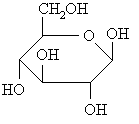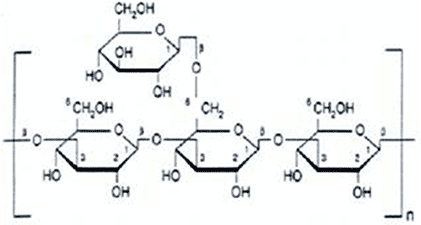A monosaccharide means one or single. It includes glucose, galactose, and fructose. Food examples of this includes honey, fruit, high-fructose corn syrup(which we get from fructose) and milk(from galactose).
 |
| Monosaccharide |
A disaccharide means two or double. When a disaccharide is created, one monosaccharide loses Hydrogen(H) and another monosaccharide loses a Hydroxyl group(OH). It includes sucrose, lactose, and maltose. Sucrose(table sugar) is made of up glucose and fructose. Lactose(milk) is made up of glucose and galactose. While, maltose(found in grains) is made up of two parts glucose.
 |
| Disaccharide |
A polysaccharide means many. This includes starches or glucose polymers.
 |
| polysaccharide |
Carbohydrates mean part hydrogen2, carbon, and oxygen. (I think this is the one question on the quiz that I actually got right. Go me!)
Starch and cellulose are carbohydrates, macromolecules, polymers, and monomers. What's the difference between a polymer and monomer you may ask? A polymer is built from repeating units while monomers are built from links, like a chain continuously building.
Glycogen!! Most animals unknowingly store excess glucose by polymerizing it forming glycogen. The glycogen then breaks back down when the energy is needed.
Cellulose is common as being plant structural material. It's also common in wood, cotton, and paper. Hydrogen bonds are common in cellulose because there are many -OH groups and oxygen atoms in the "ring".
Now onto the experiment we did:
Benedict's:
We mixed different contents with Benedict's solution to find out if it was a monosaccharide or disaccharide. After mixing the contents with the solution, and letting it sit in heated water for about two minutes, we had our results. If the contents in the test tube turned a bright orange or orange-ish color, then the solution was a monosaccharide. If it turned a brown-ish color then the solution was a disaccharide, but if the solution had no change at all it was either water or a polysaccharide.
[a great online virtual lab is: http://bioweb.wku.edu/courses/Biol114/Online/Carbo/carbo1.asp]
Iodine:
We mixed a few different contents with iodine in a test tube. If the contents turned a bright, noticable blue color then the contents were startches. If they didn't then, well, they weren't starches.
[a great online virtual lab is: http://www.purchon.com/biology/food.htm]
Self Evaluation: I suck at taking tests/quizzes/whatever you want to call them. BUT!! It's a work in progress. I just need to find a way that I learn best, and I think I've found it!
No comments:
Post a Comment